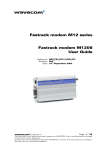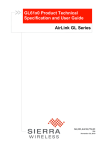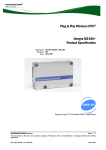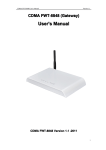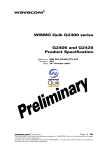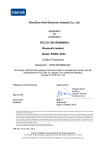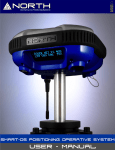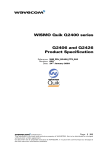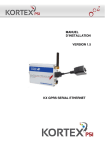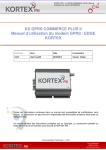Download Wavecom CM52 User guide
Transcript
C-GPS Overview and Usage APN Content Level Software Compatibility* FW: BASIC 6.61 9 INTERMEDIATE Open AT® 4.11 SDK: Plug-Ins: M2mpower * refer to software compatibility matrix section for more detail Plug & Play: M1306B Quik (CDMA): Q2438F Q2400A Wireless CPU Quik (GSM): GR64 Compatibility Q24 Classic Wireless Microprocessor WMP100 Confidentiality ADVANCED M2106B Q2438R Q2406A GS64 Q24 Plus WMP150 TCP/IP 9 C-GPS Internet 9 Bluetooth MQTT 9 M2MC CM52 Q2406B Q2686H Q24 Extended 9 Public Compiler Used: RTE: Q2426B Q2687H Q24 Auto ADS GCC 9 9 Private Reference Hardware Reference Software Yes Yes Q2501B 9 1 VERSION NOT E WM_DEV_C-GPS_APN_001-001 Date: 30th November 2006 Wavecom Support Consultant APP LICATION Author: Application Notes may be updated over their lifetime. To ensure you design with the correct version, please check the application notes page in the support section for www.wavecom.com. This APN (Application Note) is provided to Wavecom distributors and clients to aid more rapid development of embedded applications using the Wavecom portfolio of cellular solutions. To request a new application note, contact your regional Wavecom Product Marketing Manager. 3 APPLICATION NOTE DESCRIPTION ® Wavecom provides sample Open AT applications which can be used to provide guidelines to create customized application based on the requirements. 4 HARDWARE CONFIGURATION The C-GPS Daughter board is connected to the J201 connector of the wireless CPU development board. This is shown in the picture below: The C-GPS Daughter board has the following layout: NOT E 4.1 Daughter Board APPLICATION The C-GPS chipset uses one of the available UART to send/receive data from the Wavecom Wireless CPU. Hence, to be able to receive the C-GPS data from the C-GPS chipset, FCM flow ® must be subscribed by the Open AT application. As one of the UART is internally used by the GPS chipset, it is not possible to use this UART for any external application (like Terminal Emulator, TMT or Hyperterminal). However, the UART which is not used by GPS chipset can be used to interface with an external application. This UART can be used to send/receive AT commands/responses and also send the NMEA sentences. The C-GPS Daughter board hence gets access to all the pins that are provided on the J201 connector. Using these pins, the C-GPS Daughter board is able to send/receive data to/from the Wavecom Wireless CPU and hence able to interact with it. The Daughter Board has the following main components: 1. GPS Antenna Connector: This connector is used to connect the external GPS antenna with the C-GPS chipset. Please note that the connection should be made using an active antenna. 2. UART1/UART2 configuration switch: This switch is used to select whether UART1 or UART2 is used by the C-GPS Daughter board to communicate with the Wireless CPU. If the switch is set to “UART1”, then the Rx and Tx pins of UART2 will be used by C-GPS Daughter board to send/receive the GPS data. Hence, this UART cannot be used by the external application (like TE/Hyperterminal). The “UART1” in this case, becomes the debug UART and can be used to send/receive AT commands and receive the NMEA messages. Similarly, if the configuration switch is set to UART2, then the C-GPS Daughter board is configured to © 2006 All rights reserved Page: 1 / 7 This document is the sole and exclusive property of WAVECOM. Not to be distributed or divulged without prior written agreement. Ce document est la propriété exclusive de WAVECOM. Il ne peut être communiqué ou divulgué à des tiers sans son autorisation préalable. Template: WM ACM F 007 level002 The acronym C-GPS stands for Companion GPS. Wavecom offers its customers to ease the integration process of the GPS functionalities with its GSM/GPRS Wireless CPU’s by offering a ® ready-made library within the Open AT environment. This library allows driving a Companion GPS chipset. In this release, the GPS solution is the Opus One from eRide, Inc. In order to facilitate evaluation, testing and development, Wavecom makes available a development kit which includes a C-GPS Daughter board. This development kit can be ordered from Wavecom and Wavecom distributors. The C-GPS chipset receives the GPS data, performs the preliminary processing on the data and forwards the data to the ® Wavecom Wireless CPU. The Open AT application executed on the Wavecom Wireless CPU receives this data and performs processing based on the received data. The application need not take care for low level interfacing with the GPS chipset as Wavecom provides C-GPS library which performs the task of managing the lower level details. APPLICATION NOT E 2 INTRODUCTION C-GPS Overview and Usage WM_DEV_C-GPS_APN_001-001 In addition to the above interface characteristics of the C-GPS board, the C-GPS chipset requires the following signals to be driven: • NRST: This input signal is used to reset the C-GPS Daughter board. • GPS_ENABLE: This signal is used to enable the acquisition of GPS NMEA sentences by the GPS Daughter board. • TCXO_ENABLE: This signal is used to enable the temperature compensated crystal oscillator. Warning: DC voltage (VBATT) is always present on the “RF” connector in order to power supply an antenna with LNA. References: For further reference on the details of working of Daughter board, please refer to C-GPS Development kit User Guide (document [2]). 4.2 Configuration on Wavecom Motherboard The motherboard of the Wavecom Wireless CPU which is connected to the C-GPS Daughter board should also be configured for proper working of the C-GPS Daughter board. The following image depicts the wireless CPU motherboard which can be connected to the C-GPS Daughter board. NOT E APP LICATION 1. 2. 3 4. NRST GPS_ENABLE TCXO_ENABLE LED GPIO providing signal GPIO19 GPIO 22 GPIO 23 GPIO 20 the 4.2.1 Configuration of Motherboard The motherboard should be configured by providing the correct switch position for “EN1/GPIO19” switch and “EN2/GPIO1” switch. In case the user is planning to use UART1 for C-GPS, the “EN1/GPIO19” switch must be set to select GPIO19. Also, “EN2/GPIO1” switch must be set to EN2 to enable UART2 for the PC. In case the user is planning to use UART2 for C-GPS, the “EN2/GPIO1” switch must be set to select GPIO1. Also, “EN1/GPIO19” switch must be set to EN1 to enable UART1 for the PC. In addition to these configurations, the ON/OFF switch must be set to ON and the Boot switch must be set to OFF. 5 C-GPS Open AT® Applications ® Wavecom provides sample Open AT applications which ® demonstrate how Open AT applications can be created which can be used to interface with the C-GPS Daughter board. The following samples are provided by Wavecom: 1. Query Application 2. Interval Update Application 3. TCP Internet Connection Application Important Note: ® RTE mode is available with restrictions; see the Open AT SDK Customer Release Note. NOT E Signal to be connected APPLICATION The C-GPS Daughter board should be connected to the J201 connector on the Wavecom Wireless CPU. In case, the user is planning to use UART1 for C-GPS, then UART1/UART2 configuration switch must be set to UART2. Selection of incorrect switch position might lead to non-working of the C-GPS Daughter board. The C-GPS Daughter board has the following serial communication parameters: Baud Rate: 57600 bps • Character Framing: 8 Data bits, 1 stop bit and Odd • Parity. • Flow control: No flow control ® These parameters need to be set by the Open AT application which is interacting with the C-GPS Daughter board. S.No. NOT E 4.1.1 Configuration of Daughter Board C-GPS Daughter board requires the NRST, GPS_ENABLE and ® TCXO_ENABLE to be driven by the Open AT application. These pins are connected with the following GPIOs on the Motherboard: APPLICATION NOTE: The GPS FIX LED is internally connected to GPIO20 of the Wireless CPU. UART2/ GPIO1 switch UART1/ GPIO19 switch RTE mode may work with C-GPS if the baud rate is 460800 for the UART used with the PC. ® In Open AT SDK v4.11 in RTE mode you have to set the RTE_PRODUCT_TYPE definition in "gpioconfig.h" (header file used in the samples) to select your target. The following statements should be added to be able to execute the application correctly in RTE mode. -> When Q2686 Wireless CPU is used, add the following lines of code: /***********/ /*Constants*/ /***********/ #if defined ( __REMOTETASKS__ ) /* Define the product type only for RTE mode */ /* ADL_IO_PRODUCT_TYPE_Q2686 or ADL_IO_PRODUCT_TYPE_Q2687 */ © 2006 All rights reserved Page: 2 / 7 This document is the sole and exclusive property of WAVECOM. Not to be distributed or divulged without prior written agreement. Ce document est la propriété exclusive de WAVECOM. Il ne peut être communiqué ou divulgué à des tiers sans son autorisation préalable. Template: WM ACM F 007 level002 3. use UART1 for communicating with the Wireless CPU (by using the Tx and Rx pins internally). Hence, UART1 cannot be used for any external application (like TE or Hyperterminal). In this case, UART2 becomes the Debug UART and Hyperterminal/TE can be connected to UART2 to receive the Debug Traces and GPS data. GPS Fix LED: A LED has been provided on the C-GPS Daughter board. This LED indicates whether GPS fix has been achieved or not. The behaviour of this LED is as follows. • If GPS fix has not been achieved, the LED keeps on glowing. • As soon as GPS fix is achieved, the LED starts blinking. The LED blink frequency is the same as the one with which the NMEA frames are sent to the external application. • If GPS fix is lost, then again, the LED stops blinking and keeps on glowing. C-GPS Overview and Usage NOTE: To retrieve the PVT information, the user has to send a configuration SMS to the Wireless CPU where the Query Application is in execution. The Configuration SMS should have the following format: INFO:<Password>:<Phonenumber> 1. <Password>: This is the Password which is configured using AT+PASSWORD command. The default value of the password is “CGPS”. 2. <Phonenumber>: This is the optional field which conveys the phone number to which the PVT information is sent. If the phone number is missing, the information is sent to the number from which the configuration SMS has been received. For instance, INFO:CGPS:994587883 5.2 Interval Update Application This sample application uses the C-GPS Daughter board to receive the GPS information. The user can send an SMS (called the configuration SMS) to the Wavecom Wireless CPU where the application is executing. The configuration SMS is used to configure the sample to send the PVT information after a fixed interval of time repeatedly using either SMS or TCP socket as a bearer. It must be noted that the user must specify the correct password in the configuration SMS (which is configured on the Wireless CPU where the sample is in execution). The password is configured using AT+PASSWORD command. The user also specifies the bearer to be used (SMS/TCP socket i.e. IP connection) to repeatedly send the PVT information along with the update interval (interval after which the PVT information will be sent). In case, TCP socket is used to send the PVT information, the user must specify the IP address and Port of the server which will be used by the sample application to connect to. In addition to this, the configuration SMS must also specify the Access Point For Instance, INFO:CGPS:SMS:994598883:30 • IP Bearer INFO:<Password>:IP:<IPAddr>:<Port>:<APN>,<Username>,<Pas sword>:<Optional Interval> For Instance, INFO:CGPS:IP:10.15.22.33:80:testapn,myusername,mypwd:20 Stopping a Bearer: INFO:<Password>:STOP For Instance, INFO:CGPS:STOP APP LICATION NOT E NOTE: To retrieve the PVT information, the user has to send a configuration SMS to the Wireless CPU where the Interval Update Application is in execution. The Configuration SMS should have the following format: • SMS bearer INFO:<Password>:SMS:<OptionalPhonenumber>:<Optional Interval> APPLICATION This sample application uses the C-GPS Daughter board and receives the GPS data from it. The user can send an SMS (called configuration SMS) to the Wavecom Wireless CPU where the application is in execution to get the PVT (Position, Velocity and Time) data. The PVT data is sent using an SMS to the user. The user has to specify a password (which is configured at the Wireless CPU where the Query Application Sample is running) to be able to receive the PVT data. The user can also specify a different phone number to which the SMS containing the PVT data would be sent. The application can also be configured to display the NMEA sentences received from the C-GPS Daughter board (either in formatted NMEA format or in RAW format) using a customer AT command (AT+NMEA). These frames can be received over the Debug UART. Hence, the user can use mapping software to get the GPS coordinates. References: For more information, as to how the sample works, please refer to the Query Application sample description HTML document. (This document is present in the /Samples/QueryApp ® directory in Open AT installation) This document describes the custom AT commands which can be used to configure various parameters for the sample application and the format in which the PVT information is sent. Please refer to the Interval Update Sample Description HTML document form more information on the above mentioned fields in the configuration SMS. 5.3 TCP Internet Connection application This sample application depicts a use case scenario in which the user wants to send the NMEA frames to a TCP server socket which is using mapping software for GPS to calculate the position of the Wireless CPU. The application interfaces with C-GPS Daughter board to receive the GPS information. A configuration SMS is sent to the Wavecom Wireless CPU where the application is in execution and configures the IP address, port, access point name, access point username and access point password for establishing a TCP socket. The configuration SMS also provides the update interval (interval after which the NMEA data is sent to the TCP server). Like the previous samples, this application too requires the user to give a password in the configuration SMS which is configured using AT+PASSWORD command. After receiving the configuration SMS, the sample establishes a TCP socket and sends the NMEA sentences over the established socket. References: For more information, as to how the sample works, please refer to the TCP Internet Connection Sample Description HTML document. This document is present in the /Samples/TCP ® Server directory in Open AT installation). This document describes the custom AT commands which can be used to configure various parameters for the sample application. NOTE: The configuration SMS that is to be sent to the Wireless CPU should have the following format: INFO:<Password>:IP:<IPAddr>:<Port>:<APN>,<Username>,<Pas sword>:<Optional Interval> For Instance, INFO:CGPS:IP:10.22.33.44:80:myapn,myun,mypwd:20 To stop the bearer use: INFO:<Password>:STOP © 2006 All rights reserved Page: 3 / 7 This document is the sole and exclusive property of WAVECOM. Not to be distributed or divulged without prior written agreement. Ce document est la propriété exclusive de WAVECOM. Il ne peut être communiqué ou divulgué à des tiers sans son autorisation préalable. NOT E 5.1 Query Application APPLICATION -> When a Q2687 Wireless CPU is used, use the following code. /*Constants*/ /***********/ #if defined ( __REMOTETASKS__ ) /* Define the product type only for RTE mode */ /* ADL_IO_PRODUCT_TYPE_Q2686 or ADL_IO_PRODUCT_TYPE_Q2687 */ #define RTE_PRODUCT_TYPE ADL_IO_PRODUCT_TYPE_Q2687 #endif name, Access Point Username and Access Point Password to be able to activate the PDP context for GPRS connection. This application can also be configured to send the GPS frames (either in formatted NMEA format or in RAW format) over the Debug UART (using AT+NMEA command). Hence, the user has the flexibility to receive the NMEA frames locally and hence can use mapping software to calculate the GPS position of the Wireless CPU. References: For more information, as to how the sample works, please refer to the Interval Update Sample Description HTML document. This document is present in the ® /Samples/IntervalUpdate directory in Open AT installation). This document describes the custom AT commands which can be used to configure various parameters for the sample application and the format in which the PVT information is sent. Template: WM ACM F 007 level002 #define RTE_PRODUCT_TYPE ADL_IO_PRODUCT_TYPE_Q2686 #endif NOT E WM_DEV_C-GPS_APN_001-001 C-GPS Overview and Usage 12. APPLICATION NOT E 13. 5.4 Steps to Download the Samples NOTE: UART2 or USB cannot be used to download the Open AT application. ® 5.4.1 Downloading using XModem Protocol The user can download the sample using the XModem protocol using Hyperterminal (or a similar serial port utility which provides XModem protocol to transfer information). Following steps should be taken to download the sample 1. Connect UART1 with the PC which has the application binary. The connection parameters for Hyperterminal (or similar application should be): a. Baud Rate: 115200 bauds/sec b. Data bits: 8 data bits, no parity, 1 stop bit. 2. Set the BOOT switch on the Wavecom Wireless CPU Motherboard to OFF. The ON/OFF switch should be set to ON. Make sure that the CGPS Daughter board is not connected. 3. Execute the command AT+WDWL. The XModem NACK characters (‘$”) would start to appear. 4. Transfer the sample binary application (compilerused_workspacename_H.wpb.dwl or compilerused_workspacename_H.dwl). NOTE: The literal compilerused can have the values “ads” or “gcc” depending on the compiler which is used to compile the application. 5. After the download is complete, execute AT+CFUN=1 command to reset the Wireless CPU. ® 6. Execute AT+WOPEN=1 command to start the Open AT sample application. 5.4.2 Downloading using DwlWin Wavecom provides a utility called DwlWin which can be used to download the sample applications. The steps to download the sample are: 1. Connect to UART1 (115200 bauds, 8 data bits, no parity, 1 stop bit). 2. On the Wavecom Wireless CPU Development Board set the boot switch to ON. 3. Configure DWLWIN as shown below. 4. Make sure the C-GPS Daughter board is not connected. 5. Select the sample application having the extension .wpb at the end. 6. Start the download. 7. Once completed, switch the boot back to OFF. 8. Connect the C-GPS Daughter board. 5.5 Steps to Execute the Samples ® To start the Open AT application, the command AT+WOPEN=1 needs to be given. The user must configure the switch positions on the Daughter board (to select the UART to be used for C-GPS) and the switch positions on the Wavecom Wireless CPU motherboard as described earlier in this document. All the samples subscribe to a set of custom AT commands which define the way in which the sample behaves. The set of AT commands along with their description are: 1. AT+NMEA: This command specifies if the NMEA frames (either in formatted or in RAW format) are to be received over the Debug UART. 2. AT+PASSWORD: This command specifies the password to be used in the configuration SMS to authenticate a valid user. The password is stored in flash memory. The default value of the password is “CGPS” and the password is case sensitive. 3. AT+CGPS: This command provides information as to which UART is to be used for C-GPS Daughter board. The UART which is left automatically becomes the Debug UART. After giving this command, the sample starts executing. 4. AT+CONFIG: If a value of 1 is specified as an argument to this command, then the values for AT+NMEA and AT+CGPS are saved in flash memory. Hence, if the Wireless CPU resets, the sample application automatically starts executing (without user intervention) using the previously saved parameters for +NMEA and +CGPS commands. Please note that to disable this © 2006 All rights reserved Page: 4 / 7 This document is the sole and exclusive property of WAVECOM. Not to be distributed or divulged without prior written agreement. Ce document est la propriété exclusive de WAVECOM. Il ne peut être communiqué ou divulgué à des tiers sans son autorisation préalable. NOT E POINTS TO REMEMBER: 1. The difference between the TCP Internet Connection sample and the Interval Update sample is that the TCP Internet Connection sample sends the data in exact NMEA format over the established TCP socket. The Interval Update sample, on the other hand, sends data in a particular format (used for sending PVT information). Another difference between the TCP Internet Connection sample and the Interval Update sample is that the TCP Server sample sends NMEA sentences only over TCP socket after a specified update interval whereas the Interval Update sample can be used to send PVT data over TCP socket or SMS after a specified update interval. 2. All the sample applications use the following serial port communication parameters for the Debug UART: Speed: 115200 Bauds/second. Character Framing: 8 data bits, 1 stop bits, parity ignored. Flow control: No flow control. 10. 11. APPLICATION For more information on the meanings of various fields of the configuration SMS, please refer to the TCP Internet Connection Sample Description HTML document. Set UART1/UART2 switch on C-GPS Daughter board to UART2. Push the hardware reset. ® If needed start the Open AT application using AT+WOPEN=1. Connect to the port UART2 (115200 bauds, 8 data bits, no parity, 1 stop bit). NMEA should be sent to the UART2. APP LICATION 9. Template: WM ACM F 007 level002 For Instance, INFO:CGPS:STOP NOT E WM_DEV_C-GPS_APN_001-001 C-GPS Overview and Usage WM_DEV_C-GPS_APN_001-001 This section provides vital statistical information regarding the performance and NMEA Frame description. 6.1 Performances 6.1.1 Footprint C-GPS ARM lib footprint Memory Footprint: • ROM : 245397 Bytes • RAM (static): 106293 Bytes C-GPS CPU load: Normal mode C-GPS C-GPS with NMEA frame 48% 49% Boost activated C-GPS C-GPS with NMEA frame 40% 45% NOT E ® Velocity Accuracy Static mode First fix only TTFF Hot Start TTFF Warm Start TTFF Cold Clear Start conditions Clear conditions Update Rate -130 dBm Sky Sky 3,7 m CEP 6,8 m CEP 6,1 m CEP 13,9 CEP m 0,1 m/s Typ 0 m/s Typ 3,5 s Typ Mean 30s Typ Mean 38 s Typ 95% percentile 45 s Typ Continuous fixes 1 Hz Typ 1,1 dB Typ Continuous fixes Mean Static mode APP LICATION -130 dBm(outdoor) In 50% percentile dynamic mode -130 dBm(outdoor) In 95% percentile dynamic mode -140 dBm In 50% percentile dynamic mode -145 dBm In 50% percentile dynamic mode Accuracy Value Desensitizatio 1 GSM burst Continuous n due to GSM over 8 slots fixes Tx bursts NOT E Notes APPLICATION Open AT SDK Conditions v 4.11 6.2 Description of NMEA Frames NMEA 0183 standard defines the NMEA sentences and for each of these sentences the first word, called a data type defines how the rest of the sentence is interpreted. Each data has its own unique interpretation, as defined by the NMEA standard. Sentences vary in the information they contain. Some sentences will repeat some of the information already provided, while others provide new data. Type of NMEA tags included in the C-GPS sample application are: • $GPGLL Geographic Position, Latitude/Longitude • $GPGSV GPS Satellites in View Data • $GPZDA UTC Date & Time • $GPGGA Global Positioning System Fix Data • $GPVTG Course over ground and ground speed • $GPGSA GPS DoP (Dilution of Precision) and Active Satellites • $GPRMC Recommended Minimum Specific GNSS GPS/TRANSIT Data This section describes what information is included in which NMEA sentence and how to interpret various fields in the NMEA sentence: NOT E 6 Annexes 6.1.2 GPS APPLICATION feature, the user should give AT+CONFIG=0 command and then reset the Wireless CPU. Using the above mentioned commands, the following steps should be used to execute the sample applications: 1. Execute AT+WOPEN=1 command. 2. Set the password (if required) for authenticating the configuration SMS using AT+PASSWORD command. 3. Set the availability of NMEA frames over the Debug UART using AT+NMEA command. 4. Execute the AT+CGPS command to select the UART which must be used by the C-GPS Daughter board. The parameter given for the command must be coherent with the switch position provided on the C-GPS Daughter board. The C-GPS sample application will start at this point of time and will take roughly 15 seconds to receive the NMEA frames. If AT+NMEA command is configured to display the NMEA frames over the Debug UART, then the frames will be received over the UART after 15 seconds. 5. If the parameters set using AT+NMEA and AT+CGPS commands are to be saved, then the command AT+CONFIG=1 should be issued. In this case, after Wireless CPU reset, the application would automatically start using the saved parameters and there is no need for the user to execute AT+NMEA and AT+CGPS commands again. To prevent the Wireless CPU from using the same configuration again and again (after reset), the command AT+CONFIG=0 should be given and the Wireless CPU should be reset. 6. The configuration SMS should be sent to the Wireless CPU. If the password and the format of the configuration SMS is correct, the PVT information will be sent to the provided phone number. Reference: Please refer to the HTML help available in the corresponding samples directory for more information on the format of configuration SMS and the PVT information. 6.2.1 GLL (Geographic Position Latitude Longitude) C-GPS GCC lib footprint Memory Footprint: • ROM : 304371 Bytes • RAM (static): 29263 Bytes C-GPS CPU load: Normal mode C-GPS C-GPS with NMEA frame 47% 53% Boost activated C-GPS C-GPS with NMEA frame 40% 45% • • • • • • • llll.ll Destination waypoint latitude E N or S (for latitude) yyyyy.yy Destination waypoint longitude F E or W (for longitude) hhmmss.ss UTC of position fix (time) A Data Status (A = OK, V = Void) *hh Checksum 6.2.2 GSV (Satellites in View Data) $GPGSV,A,B,C,D1,E1,Az1,SNR1,D2,E2,Az2,SNR2,D3,E3,A z3,SNR3,D4,E4, Az4,SNR4*hh © 2006 All rights reserved Page: 5 / 7 This document is the sole and exclusive property of WAVECOM. Not to be distributed or divulged without prior written agreement. Ce document est la propriété exclusive de WAVECOM. Il ne peut être communiqué ou divulgué à des tiers sans son autorisation préalable. Template: WM ACM F 007 level002 $GPGLL,llll.ll,E,yyyyy.yy,F,hhmmss.ss,A*hh C-GPS Overview and Usage $GPZDA,hhmmss.ss,dd,mm,yyyy,xx,yy,*hh • • • • • • • • • • • • • • • • • • • hhmmss.ss UTC of position fix (time) A Data Status (A = OK, V = Void) llll.ll Destination waypoint latitude E N or S (for latitude) yyyyy.yy Destination waypoint longitude F E or W (for longitude) SOG Speed Over Ground (knots) COG Course Over Ground (°) Ddmmyy Date Stamp coordinated MV Magnetic Variation (°) F East or West Magnetic Variation Direction M Mode indicator A= Autonomous D= Differential E= Dead Reckoning, N= None *hh Checksum hhmmss.ss UTC of position fix (time) dd Day mm Month yyyy Year xx Local zone hours (-13 to 13) yy Local zone minutes (00 to 59) *hh Checksum 6.2.4 GGA (Global Positioning System Fix Data) $GPGGA,hhmmss.ss,llll.ll,E,yyyyy.yy,F,A,bb,x.x,y.y,M,z. z,M,s.s,####,*hh • • • • • • • • • • • • • hhmmss.ss UTC of position fix (time) llll.ll Destination waypoint latitude E N or S (for latitude) yyyyy.yy Destination waypoint longitude F E or W (for longitude) A Fix quality: 0 = Invalid 1 = GPS fix (SPS) 2 = DGPS fix 3 = PPS fix 4 = Real Time Kinematic 5 = Float RTK 6 = Estimated (dead reckoning) 7 = Manual input mode 8 = Simulation mode bb Number of satellites in use x.x Horizontal error (precision) y.y,M Antenna height in meters z.z,M Height of geoid (mean sea level) in meters s.s Time in seconds since last update #### DGPS station ID *hh Checksum 6.2.5 VTG (Course over Ground and Ground Speed) • 7 PACKAGE DELIVERABLES This application note is delivered as a single compressed zip archive as follows: Filename WM_DEV_C-GPS_APN_001-001.zip • COG,T Course over Ground (T = true) COG,M Course over Ground (M = magnetic) SOG,N Speed over Ground (N= knots) SOG,K Speed over Ground (K = km/h) M Mode indicator A= Autonomous D= Differential E= Estimated (Dead Reckoning) N= None *hh Checksum Description Application Note 7.1 DOCUMENTATION - This application note eRide APIs Technical Manual C-GPS Development kit User Guide Samples description document 8 RELATED DOCUMENTS [1] Filename eTM-GCLAPI-CoreLib_API.pdf [2] WM_DEV_C-GPS_UGD_001 [3] [4] MiniRide Datasheet.pdf Prelude1 RF Receiver Datasheet.pdf Opus1, GPS Receiver Datasheet.pdf MG-001ApprovalSheet.pdf $GPVTG,COG,T,COG,M,SOG,N,SOG,K,A*hh • • • • • [5] [6] Description eRide APIs Technical Manual C-GPS Development kit User Guide MiniRide Datasheet Prelude1 Datasheet Opus1 Datasheet Specification for approval 6.2.6 GSA (GNSS DOP – Dilution of Precision and active satellites) $GPGSA,OM,NM,D1-D12,PDOP, HDOP, VDOP*hh • • • APP LICATION $GPRMC,hhmmss.ss,A,llll.ll,E,yyyyy.yy,F,SOG, COG,ddmmyy,MV,F,M*hh 6.2.3 ZDA (Date and Time) NOT E 6.2.7 RMC (Recommended Minimum Specific Data) APPLICATION • • • • • • NM Navigation Mode 1 : Fix not available 2 : 2D 3 : 3D D1-D12 Satellite Vehicles Used in Position Fix PDOP Position Dilution of Precision (PDOP) HDOP Horizontal Dilution of Precision (HDOP) VDOP Vertical Dilution of Precision (VDOP) *hh Checksum NOT E • • APPLICATION • • • • • A Number of messages required to hold data on all SVs in view B Message number C Total number of satellites in view D1-D4 Satellite PRN number E1-E4 Elevation in degrees (90 maximum) Az1-Az4 Azimuth (measured in degrees from True north, 000 to 359 SNR1-SNR4 Signal-to-noise ratio (the higher the number the better the signal) *hh Checksum OM Operation Mode M : Manual forced to operate in 2D or 3D A : Automatic 2D/3D © 2006 All rights reserved Page: 6 / 7 This document is the sole and exclusive property of WAVECOM. Not to be distributed or divulged without prior written agreement. Ce document est la propriété exclusive de WAVECOM. Il ne peut être communiqué ou divulgué à des tiers sans son autorisation préalable. Template: WM ACM F 007 level002 • NOT E WM_DEV_C-GPS_APN_001-001 C-GPS Overview and Usage 9 SOFTWARE COMPATIBILITY MATRIX List all current software configurations and compatibility with this application note. ® ® Open AT SDK 4.11 Open AT Plug-Ins WIP v1.10.02 10 SUPPORT For direct clients: contact your Wavecom FAE For distributor clients: contact your distributor FAE For distributors: contact your Wavecom FAE APP LICATION ® Open AT FW 6.61 NOT E WM_DEV_C-GPS_APN_001-001 11 DOCUMENT HISTORY History Creation Author Wavecom Support Consultant 12 LEGAL NOTICE LICENCE RIGHTS Wavecom Asia Pacific Ltd hereby grant licence to users of their Open AT (TM) development environment to use the source code in this electronic file for the sole use of developing GSM, GSM/GPRS or GSM/GPRS/GPS cellular applications compatible with Wavecom products. The source code may be modified by any Open AT (TM) developer providing the application is not intended to be malicious or detrimental to cellular operators or consumers of the application in any way. The licence also grants permission to copy and distribute this source code so long as this licence header is maintained in all source code files. You hereby undertake to use the Software for your interim development purposes only and under no circumstances shall you use the Software for commercial purposes. For the avoidance of doubt, the Software may not be sold for a fee on diskette or CD-ROM, either alone or as part of a collection with other products without prior written consent from Wavecom. DISCLAIMER OF WARRANTY This Software is provided free of charge on an 'as is' basis. No warranty whether expressed or implied is given by Wavecom in relation to the Software of the uses to which it may be put by you, the user, or its performance or merchantability, fitness or suitability for any particular purpose or conditions; and/or that the use of the Software and all documentation relating thereto (the “Documentation”) by the Licensee will not infringe any third party copyright or other intellectual property rights. Wavecom shall furthermore be under no obligation to provide support of any nature for the Software and the Documentation. LIMIT OF LIABILITY In no event shall Wavecom be liable for any loss or damages whatsoever or howsoever caused arising directly or indirectly in connection with this licence, the Software, its use or otherwise irrespective of whether Wavecom has had advance notice of the possibility of such damages or not by your use of the Software. Notwithstanding the generality of the foregoing, Wavecom expressly excludes liability for indirect, special, incidental or consequential loss or damage which may arise in respect of the Software or its use, or in respect of other equipment or property, or for loss of profit, business, revenue, goodwill or anticipated savings. NOT E Date 23/11/2006 APPLICATION Level 001 Template: WM ACM F 007 level002 APPLICATION NOT E INTELLECTUAL PROPERTY For the avoidance of doubt, no right, title or interest in any intellectual property right in respect of the Software shall pass to you. Any and all intellectual property rights in respect of the Software and Documentation shall at all times remain the sole and exclusive property of Wavecom. The licence grant shall not include Intellectual Property not wholly owned by Wavecom and the customer shall exercise due diligence to ensure that the use of the information in this document does not infringe any patents in the country of origin. © 2006 All rights reserved Page: 7 / 7 This document is the sole and exclusive property of WAVECOM. Not to be distributed or divulged without prior written agreement. Ce document est la propriété exclusive de WAVECOM. Il ne peut être communiqué ou divulgué à des tiers sans son autorisation préalable.







